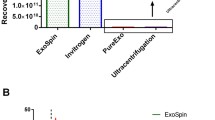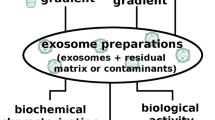Abstract
Exosomes are stable nanovesicles secreted by cells into the circulation. Their reported sizes differ substantially, which likely reflects the difference in the isolation techniques used, the cells that secreted them, and the methods used in their characterization. We analyzed the influence of the last factor on the measured sizes and shapes of hydrated and desiccated exosomes isolated from the serum of a pancreatic cancer patient and a healthy control. We found that hydrated exosomes are close-to-spherical nanoparticles with a hydrodynamic radius that is substantially larger than the geometric size. For desiccated exosomes, we found that the desiccated shape and sizing are influenced by the manner in which drying occurred. Isotropic desiccation in aerosol preserves the near-spherical shape of the exosomes, whereas drying on a surface likely distorts their shapes and influences the sizing results obtained by techniques that require surface fixation prior to analysis.







Similar content being viewed by others
References
Thery C, Zitvogel L, Amigorena S (2002) Exosomes: composition, biogenesis and function. Nat Rev Immunol 2:569–579
Trams EG, Lauter CJ, Salem N Jr, Heine U (1981) Exfoliation of membrane ecto-enzymes in the form of micro-vesicles. Biochim Biophys Acta 645:63–70
Palma J et al (2012) MicroRNAs are exported from malignant cells in customized particles. Nucleic Acids Res 40:9125–9138
King HW, Michael MZ, Gleadle JM (2012) Hypoxic enhancement of exosome release by breast cancer cells. BMC Cancer 12:421
Kucharzewska P, Belting M (2013) Emerging roles of extracellular vesicles in the adaptive response of tumour cells to microenvironmental stress. J Extracell Vesicles. doi:10.3402/jev.v2i0.20304
Chevillet JR et al (2014) Quantitative and stoichiometric analysis of the microRNA content of exosomes. Proc Natl Acad Sci U S A 111:14888–14893
Gallo A, Tandon M, Alevizos I, Illei GG (2012) The majority of microRNAs detectable in serum and saliva is concentrated in exosomes. PLoS ONE 7:e30679
Pucci F, Pittet MJ (2013) Molecular pathways: tumor-derived microvesicles and their interactions with immune cells in vivo. Clin Cancer Res 19:2598–2604
Ge R, Tan E, Sharghi-Namini S, Asada HH (2012) Exosomes in cancer microenvironment and beyond: have we overlooked these extracellular messengers? Cancer Microenviron 5:323–332
Zhang Y et al (2010) Secreted monocytic miR-150 enhances targeted endothelial cell migration. Mol Cell 39:133–144
Regev-Rudzki N et al (2013) Cell-cell communication between malaria-infected red blood cells via exosome-like vesicles. Cell 153:1120–1133
Théry C, Amigorena S, Raposo G, Clayton A (2006) Isolation and characterization of exosomes from cell culture supernatants and biological fluids. Curr Protoc Cell Biol 30:3.22.1–3.22.29
Taylor DD, Zacharias W, Gercel-Taylor C (2011) Exosome isolation for proteomic analyses and RNA profiling. Methods Mol Biol 728:235–246
Witwer KW et al (2013) Standardization of sample collection, isolation and analysis methods in extracellular vesicle research. J Extracell Vesicles. doi:10.3402/jev.v2i0.20360
Tauro BJ et al (2012) Comparison of ultracentrifugation, density gradient separation, and immunoaffinity capture methods for isolating human colon cancer cell line LIM1863-derived exosomes. Methods 56:293–304
Chen C et al (2010) Microfluidic isolation and transcriptome analysis of serum microvesicles. Lab Chip 10:505–511
Vlassov AV, Magdaleno S, Setterquist R, Conrad R (2012) Exosomes: current knowledge of their composition, biological functions, and diagnostic and therapeutic potentials. Biochim Biophys Acta 1820:940–948
Rekker K et al (2014) Comparison of serum exosome isolation methods for microRNA profiling. Clin Biochem 47:135–138
Alvarez ML, Khosroheidari M, Kanchi Ravi R, DiStefano JK (2012) Comparison of protein, microRNA, and mRNA yields using different methods of urinary exosome isolation for the discovery of kidney disease biomarkers. Kidney Int 82:1024–1032
György B et al (2011) Membrane vesicles, current state-of-the-art: emerging role of extracellular vesicles. Cell Mol Life Sci 68:2667–2688
van der Pol E, Coumans F, Varga Z, Krumrey M, Nieuwland R (2013) Innovation in detection of microparticles and exosomes. J Thromb Haemost 11(Suppl 1):36–45
van der Pol E et al (2010) Optical and non-optical methods for detection and characterization of microparticles and exosomes. J Thromb Haemost 8:2596–2607
Thery C, Ostrowski M, Segura E (2009) Membrane vesicles as conveyors of immune responses. Nat Rev Immunol 9:581–593
Bacher G et al (2001) Charge-reduced nano electrospray ionization combined with differential mobility analysis of peptides, proteins, glycoproteins, noncovalent protein complexes and viruses. J Mass Spectrom 36:1038–1052
Caulfield MP et al (2008) Direct determination of lipoprotein particle sizes and concentrations by ion mobility analysis. Clin Chem 54:1307–1316
Guha S, Pease LF III, Brorson KA, Tarlov MJ, Zachariah MR (2011) Evaluation of electrospray differential mobility analysis for virus particle analysis: potential applications for biomanufacturing. J Virol Methods 178:201–208
Guha S, Li M, Tarlov MJ, Zachariah MR (2012) Electrospray-differential mobility analysis of bionanoparticles. Trends Biotechnol 30:291–300
Pease LF et al (2010) Packing and size determination of colloidal nanoclusters. Langmuir 26:11384–11390
Wiedensohler A (1988) An approximation of the bipolar charge distribution for particles in the submicron size range. J Aerosol Sci 19:387–389
Flagan RC (2008) Differential mobility analysis of aerosols: a tutorial. KONA Powder Part J 26:254–268
Lattin JR, Belnap DM, Pitt WG (2012) Formation of eLiposomes as a drug delivery vehicle. Colloids Surf B 89:93–100
Belnap DM, Grochulski WD, Olson NH, Baker TS (1993) Use of radial density plots to calibrate image magnification for frozen-hydrated specimens. Ultramicroscopy 48:347–358
Deegan RD et al (1997) Capillary flow as the cause of ring stains from dried liquid drops. Nature 389:827–829
Nguyen TAH, Hampton MA, Nguyen AV (2013) Evaporation of nanoparticle droplets on smooth hydrophobic surfaces: the inner coffee ring deposits. J Phys Chem C 117:4707–4716
Yunker PJ, Still T, Lohr MA, Yodh AG (2011) Suppression of the coffee-ring effect by shape-dependent capillary interactions. Nature 476:308–311
Still T, Yunker PJ, Yodh AG (2012) Surfactant-induced Marangoni eddies alter the coffee-rings of evaporating colloidal drops. Langmuir 28:4984–4988
Kaufman SL, Skogen JW, Dorman FD, Zarrin F, Lewis KC (1996) Macromolecule analysis based on electrophoretic mobility in air: globular proteins. Anal Chem 68:1895–1904
György B et al (2011) Detection and isolation of cell-derived microparticles are compromised by protein complexes resulting from shared biophysical parameters. Blood 117:e39–e48
Van Deun J et al (2014) The impact of disparate isolation methods for extracellular vesicles on downstream RNA profiling. J Extracell Vesicles. doi:10.3402/jev.v3.24858
Caradec J et al (2014) Reproducibility and efficiency of serum-derived exosome extraction methods. Clin Biochem 47:1286–1292
Jeppesen DK et al (2014) Comparative analysis of discrete exosome fractions obtained by differential centrifugation. J Extracell Vesicles. doi:10.3402/jev.v3.25011
Mathivanan S, Simpson RJ (2009) ExoCarta: a compendium of exosomal proteins and RNA. Proteomics 9:4997–5000
Laulagnier K et al (2005) Characterization of exosome subpopulations from RBL-2H3 cells using fluorescent lipids. Blood Cells Mol Dis 35:116–121
Bobrie A, Colombo M, Krumeich S, Raposo G, Théry C (2012) Diverse subpopulations of vesicles secreted by different intracellular mechanisms are present in exosome preparations obtained by differential ultracentrifugation. J Extracell Vesicles. doi:10.3402/jev.v1i0.18397
Yellon DM, Davidson SM (2014) Exosomes: nanoparticles involved in cardioprotection? Circ Res 114:325–332
Kobayashi M et al (2014) Ovarian cancer cell invasiveness is associated with discordant exosomal sequestration of Let-7 miRNA and miR-200. J Transl Med 12:4
Petersen KE et al (2014) A review of exosome separation techniques and characterization of B16-F10 mouse melanoma exosomes with AF4-UV-MALS-DLS-TEM. Anal Bioanal Chem 406:7855–7866
Sharma S, Gillespie BM, Palanisamy V, Gimzewski JK (2011) Quantitative nanostructural and single-molecule force spectroscopy biomolecular analysis of human-saliva-derived exosomes. Langmuir 27:14394–14400
Sharma S et al (2010) Structural-mechanical characterization of nanoparticle exosomes in human saliva, using correlative AFM, FESEM, and force spectroscopy. ACS Nano 4:1921–1926
Sharma S, Das K, Woo J, Gimzewski JK (2014) Nanofilaments on glioblastoma exosomes revealed by peak force microscopy. J R Soc Interface 11:20131150
Conde-Vancells J et al (2008) Characterization and comprehensive proteome profiling of exosomes secreted by hepatocytes. J Proteome Res 7:5157–5166
Zhou Y et al (2013) Exosomes released by human umbilical cord mesenchymal stem cells protect against cisplatin-induced renal oxidative stress and apoptosis in vivo and in vitro. Stem Cell Res Ther 4:34
Coleman BM, Hanssen E, Lawson VA, Hill AF (2012) Prion-infected cells regulate the release of exosomes with distinct ultrastructural features. FASEB J 26:4160–4173
van der Pol E, Böing AN, Harrison P, Sturk A, Nieuwland R (2012) Classification, functions, and clinical relevance of extracellular vesicles. Pharmacol Rev 64:676–705
Momen-Heravi F et al (2012) Impact of biofluid viscosity on size and sedimentation efficiency of the isolated microvesicles. Front Physiol 3:162
Sokolova V et al (2011) Characterisation of exosomes derived from human cells by nanoparticle tracking analysis and scanning electron microscopy. Colloids Surf B 87:146–150
Tscharnuter WT (2006) Photon correlation spectroscopy in particle sizing. In Encyclopedia of analytical chemistry. Wiley, Hoboken. doi:10.1002/9780470027318.a1512
Besseling NAM (1997) Theory of hydration forces between surfaces. Langmuir 13:2113–2122
He L, Hu Y, Wang M, Yin Y (2012) Determination of solvation layer thickness by a magnetophotonic approach. ACS Nano 6:4196–4202
Tathireddy P, Choi Y-H, Skliar M (2008) Particle AC electrokinetics in planar interdigitated microelectrode geometry. J Electrostat 66:609–619
Iyer S, Gaikwad RM, Subba-Rao V, Woodworth CD, Sokolov I (2009) Atomic force microscopy detects differences in the surface brush of normal and cancerous cells. Nat Nanotechnol 4:389–393
Frank J (2002) Single-particle imaging of macromolecules by cryo-electron microscopy. Annu Rev Biophys Biomol Struct 31:303–319
Oh E et al (2011) Cellular uptake and fate of PEGylated gold nanoparticles is dependent on both cell-penetration peptides and particle size. ACS Nano 5:6434–6448
Lavialle F et al (2009) Nanovesicles released by Dictyostelium cells: a potential carrier for drug delivery. Int J Pharm 380:206–215
Varga Z et al (2014) Towards traceable size determination of extracellular vesicles. J Extracell Vesicles. doi:10.3402/jev.v3.23298
Hardij J et al (2013) Characterisation of tissue factor-bearing extracellular vesicles with AFM: comparison of air-tapping-mode AFM and liquid peak force AFM. J Extracell Vesicles. doi:10.3402/jev.v2i0.21045
Dragovic RA et al (2011) Sizing and phenotyping of cellular vesicles using nanoparticle tracking analysis. Nanomedicine 7:780–788
Momen-Heravi F et al (2012) Alternative methods for characterization of extracellular vesicles. Front Physiol 3:354
Hood JL, Pan H, Lanza GM, Wickline SA (2009) Paracrine induction of endothelium by tumor exosomes. Lab Investig 89:1317–1328
Atay S, Gercel-Taylor C, Kesimer M, Taylor DD (2011) Morphologic and proteomic characterization of exosomes released by cultured extravillous trophoblast cells. Exp Cell Res 317:1192–1202
Tian T, Wang Y, Wang H, Zhu Z, Xiao Z (2010) Visualizing of the cellular uptake and intracellular trafficking of exosomes by live-cell microscopy. J Cell Biochem 111:488–496
Tatischeff I, Larquet E, Falcón-Pérez JM, Turpin P-Y, Kruglik SG (2012) Fast characterisation of cell-derived extracellular vesicles by nanoparticles tracking analysis, cryo-electron microscopy, and Raman tweezers microspectroscopy. J Extracell Vesicles. doi:10.3402/jev.v1i0.19179
Wahlgren J, Karlson TDL, Glader P, Telemo, Valadi H (2012) Activated human T cells secrete exosomes that participate in IL-2 mediated immune response signaling. PLoS ONE 7:e49723
Ng YH et al (2013) Endometrial exosomes/microvesicles in the uterine microenvironment: a new paradigm for embryo-endometrial cross talk at implantation. PLoS ONE 8:e58502
Acknowledgments
The authors are indebted to Brian F. Woodfield of Brigham Young University (Department of Chemistry) for providing access to the NTA instrument. The authors acknowledge financial support from the National Science Foundation (award number IGERT-0903715) and the University of Utah (Department of Chemical Engineering Seed Grant and the Graduate Research Fellowship award).
Author contributions
M.S. and P.S.B. conceived the study, R.R. isolated exosomes, V.S.C. and R.R. performed NTA measurements, DLS measurements were performed by V.S.C. and M.S, D.M.B performed cryo-TEM imaging, SEM imaging was performed by Y.J. and V.S.C., electrospray DMA measurements were performed by Y.H.T., V.S.C., L.F.P., and M.S., V.S.C. and M.S. analyzed the experimental results; A.E.B. wrote the MATLAB code to analyze the imaged exosomes, M.S. performed statistical analysis, and V.S.C. and K.J.B. performed manual sizing of the imaged exosomes. The manuscript was written by V.S.C. and M.S., and was edited by all authors.
Conflict of interest
The authors declare that they have no competing financial interests.
Author information
Authors and Affiliations
Corresponding author
Electronic supplementary material
Below is the link to the electronic supplementary material.
ESM 1
(PDF 551 kb)
Rights and permissions
About this article
Cite this article
Chernyshev, V.S., Rachamadugu, R., Tseng, Y.H. et al. Size and shape characterization of hydrated and desiccated exosomes. Anal Bioanal Chem 407, 3285–3301 (2015). https://doi.org/10.1007/s00216-015-8535-3
Received:
Revised:
Accepted:
Published:
Issue Date:
DOI: https://doi.org/10.1007/s00216-015-8535-3




